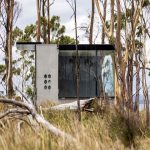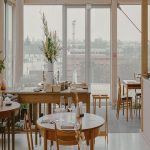Three-Storey spruce home built from foraged wood
The ciAsa (Rhaeto-Romanic for the house) is an all-wooden high-alpine family home in South Tyrol’s St. Vigil, surrounded by the Dolomites of Val Badia.
The three overground floors are entirely made from the wood that fell on 30 October 2018 during heavy storms in the surrounding forests. Massive spruce wood was joined to create the exterior and interior walls, using a special technique and avoiding the use of adhesives and resins.

GALLERY
It stands on a gentle hill, right next to a thermal spring. Based on the archaic form of a house, no distinction is made between roof and façade. The rising form of the roof makes the building visible from afar, while at the same time the low eaves lines also provide protection. The shape of the trapezoid appears as a recurring element in the overall design. To illuminate the interiors, the trapezoidal dormers are used as well as a skylight, whose light shines into the house in a cone-like shape.
Based on 6cm thick wooden planks, 36cm strong outer walls were crafted. Even within the prefabricated building components, the planks were laid in the same way as the tree had grown – from bottom to top.
On the inside, the surface consists of solid and hand-planed stone pine wood. All walls have already been prefabricated with this surface; the connections for windows and doors were rebated into the wall elements. Because of its warm color and characteristic smell, which gives the room a feeling of well-being and warmth, the stone pine has been used in local tradition for many centuries as the interior lining of the parlor. Like a pine cone, the façade is clad with hand-split larch shingles. Due to an ample wall thickness, the house achieves very good thermal values, which is why additional insulation was completely unnecessary.
The concrete for the basement consists of dolomite rock from the nearby creek, enriched with the property’s own thermal water. For this project, the aspect of sustainability was given extra high priority. The majority of the used materials are local and natural. Almost no synthetic materials had to be used. Not only is the wood of the house strictly local, but also the stone for the floors and bathrooms was cut from dolomite boulders from the valley.
The choice of materials was driven by aesthetic qualities as well as the knowledge about their resistance and durability. For example, larch wood, as used for the façade, is weather-resistant even without any treatment. Over the years, the solid woods develop a patina, giving them greater character and charm, which will make the building increasingly beautiful over time. With the construction of the ciAsa, the life cycle of the materials and resources has been extended in a meaningful way.
Environmental impact and costs are thus reduced in the long term. Great importance was also attached to the social and cultural aspects of sustainability. Only craftsmen from the valley were involved, who were able to enrich the project with their experience and expertise in local construction methods. The perpetuation of local traditions in modern ways respects the local culture and preserves millennia-old knowledge, which is endangered due to high-tech developments and the increasing standardization of new buildings.
Images by Gustav Willeit via Arch Daily
Danish design brand Vipp has ventured to the Southern Hemisphere with the launch of its latest guesthouse, Vipp ...
Situated six storeys above ground, Freia is a striking new addition to Nantes’ urban landscape. Designed by local ...








